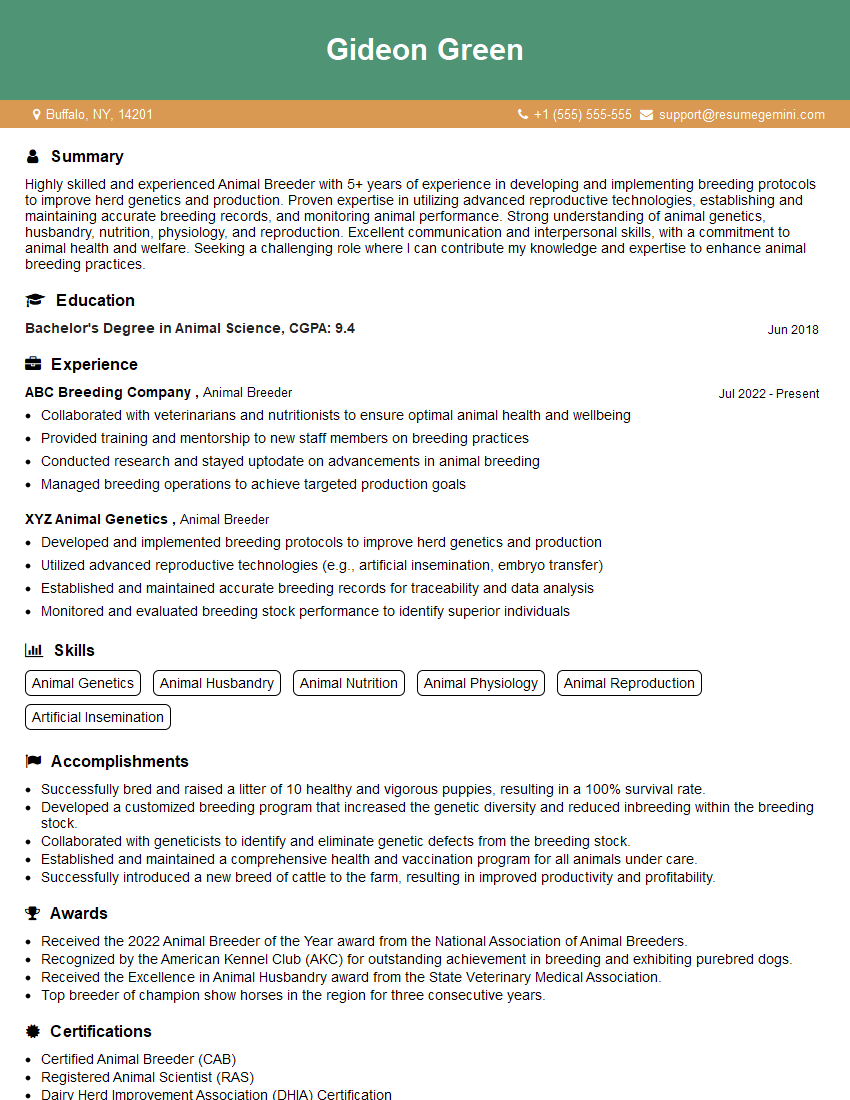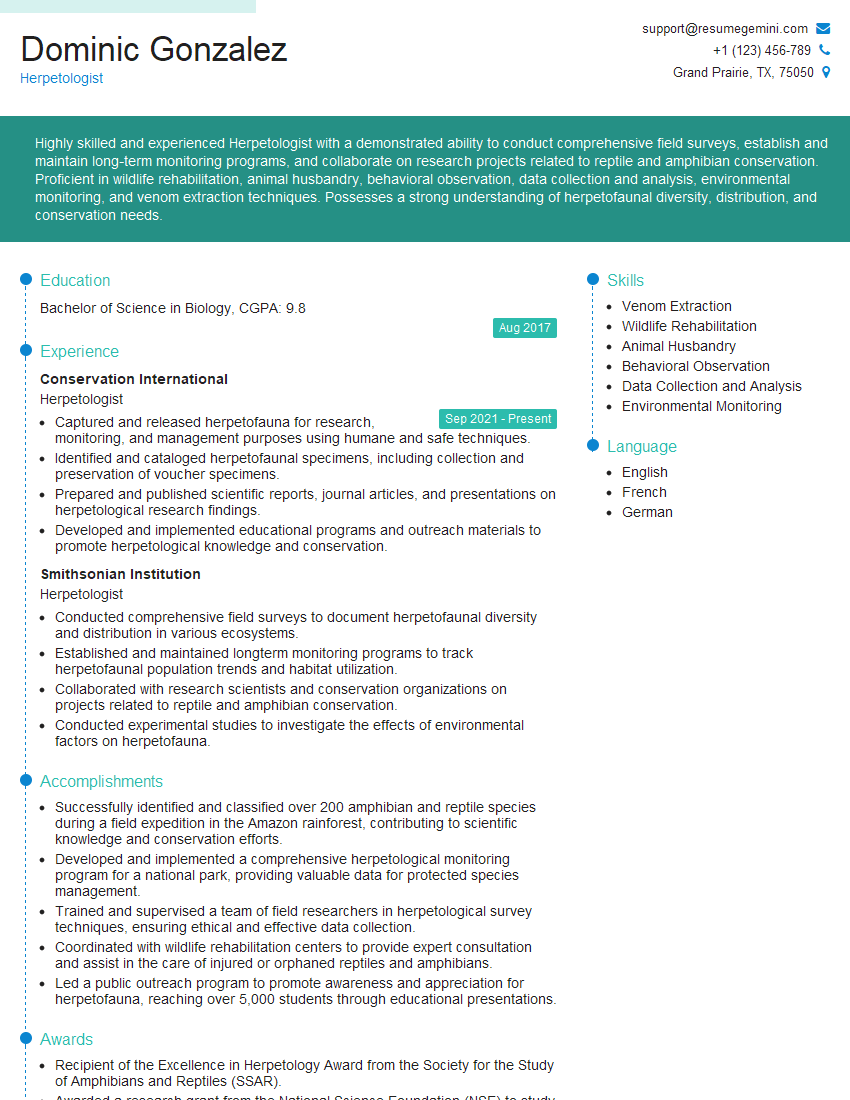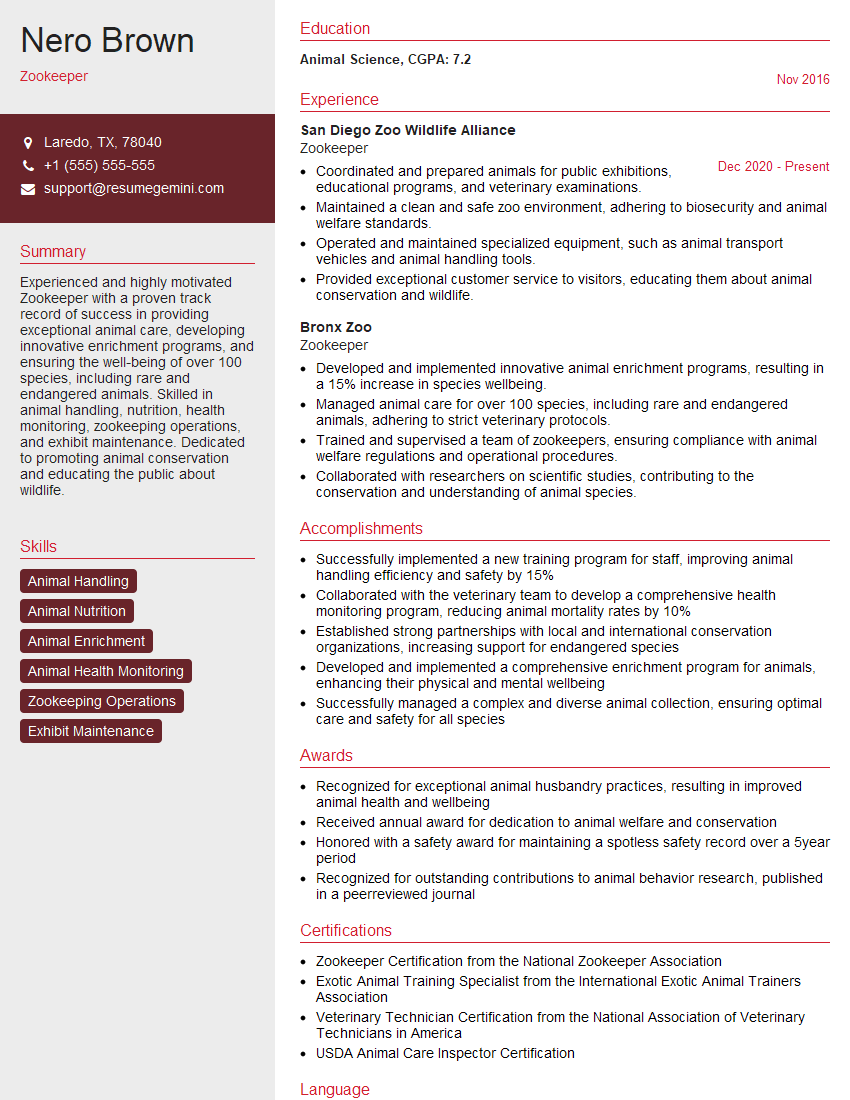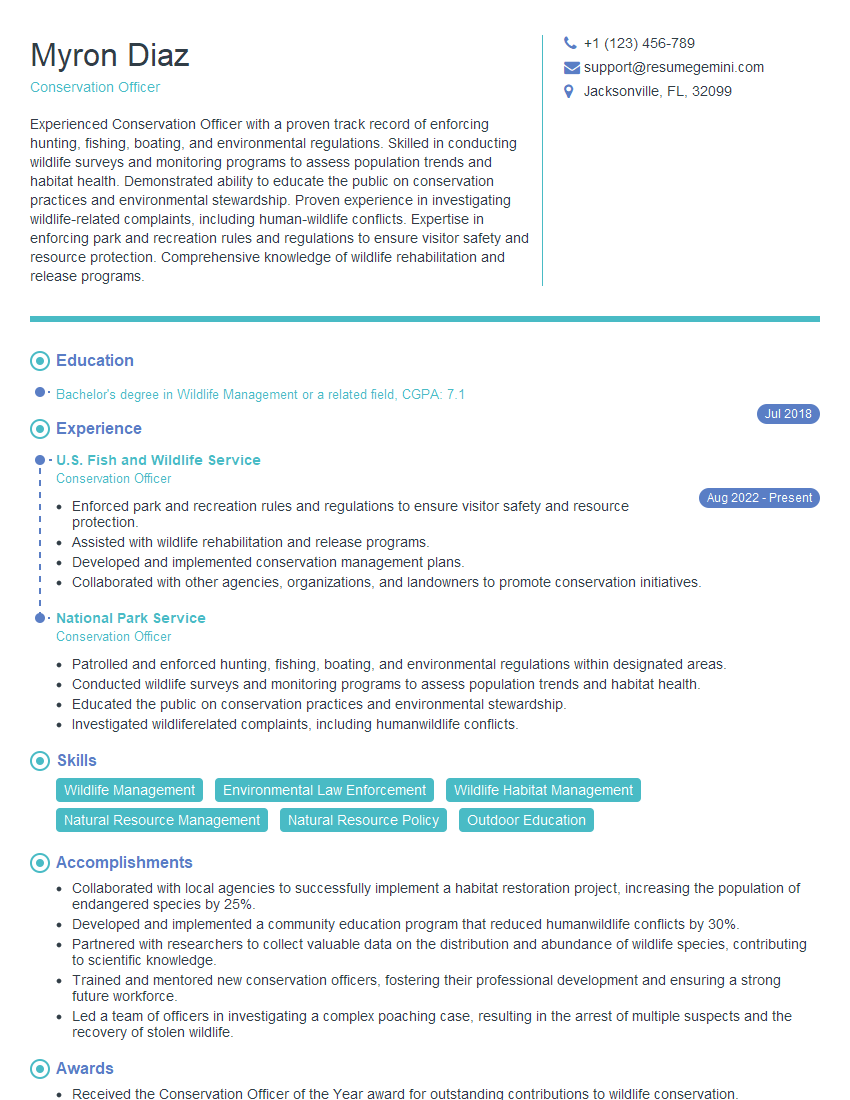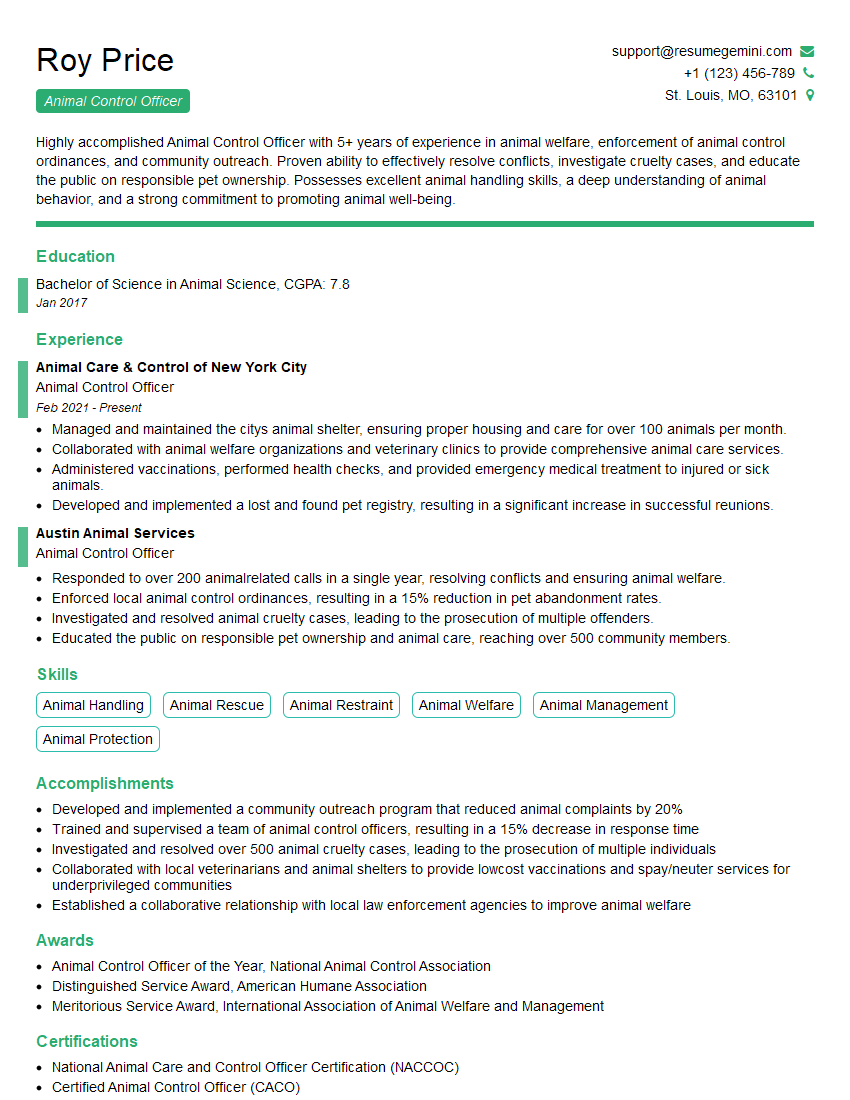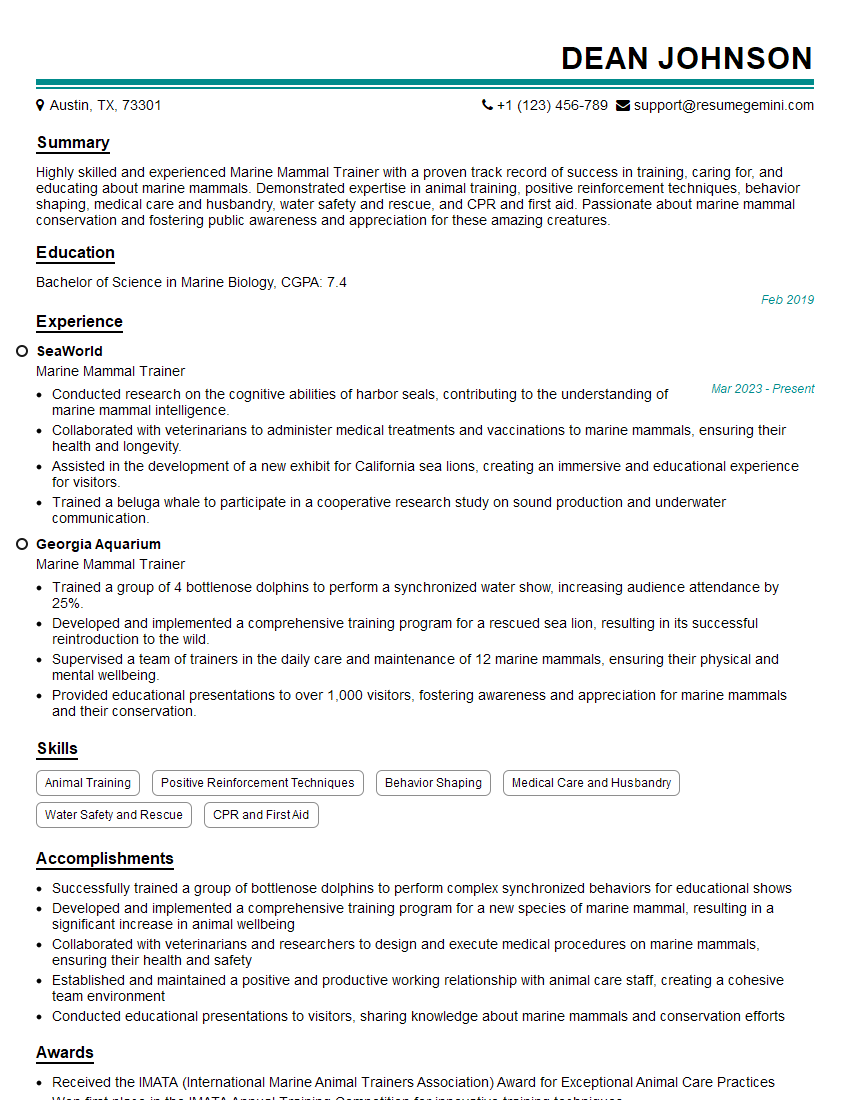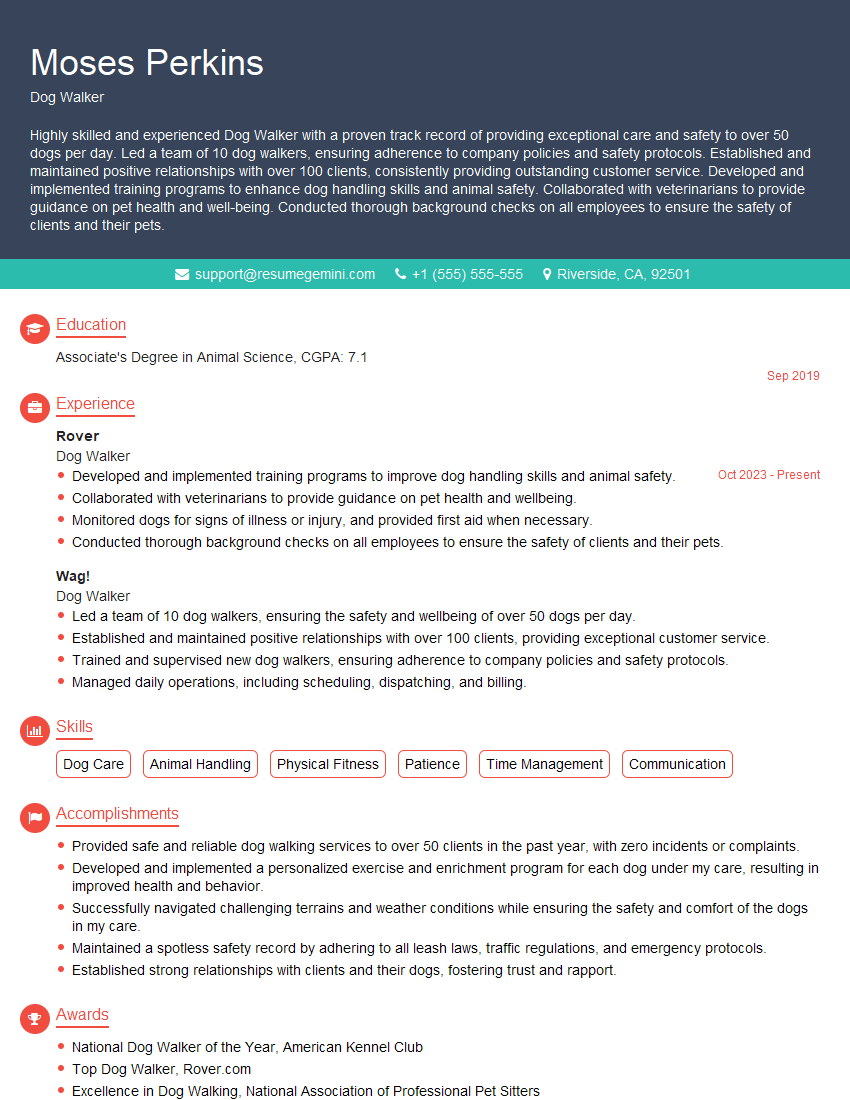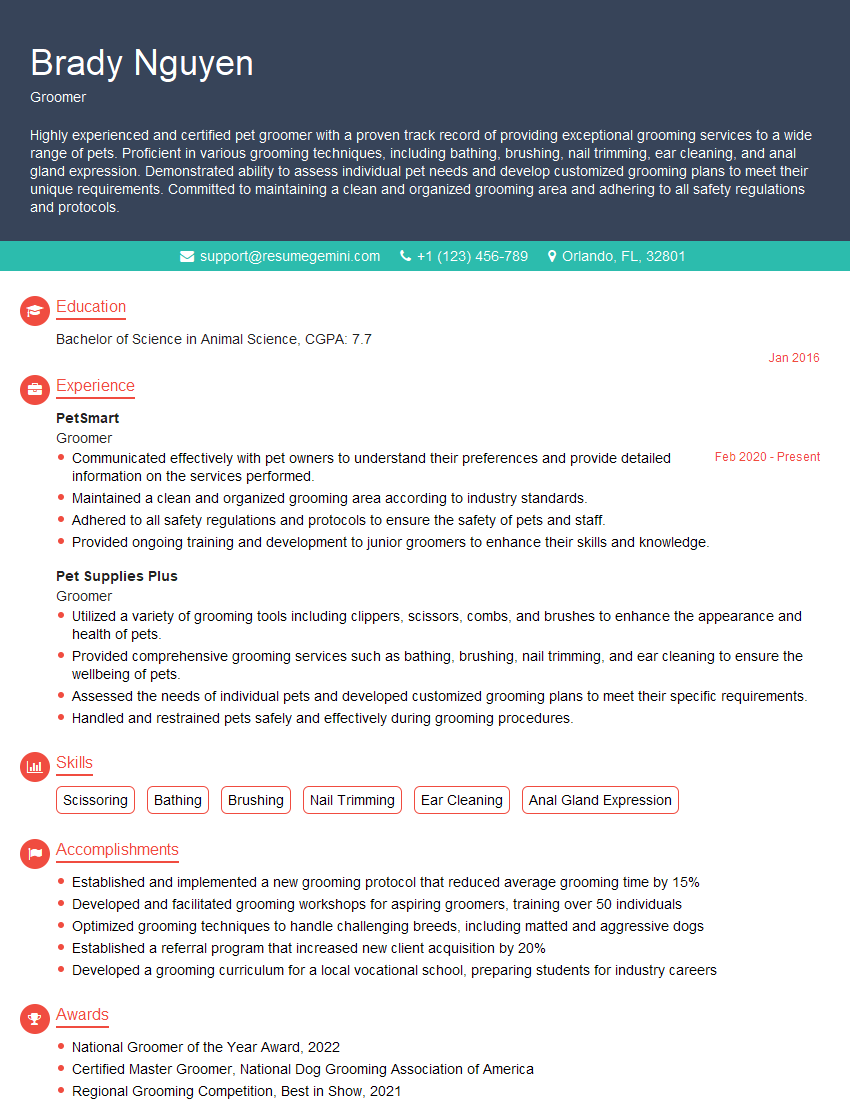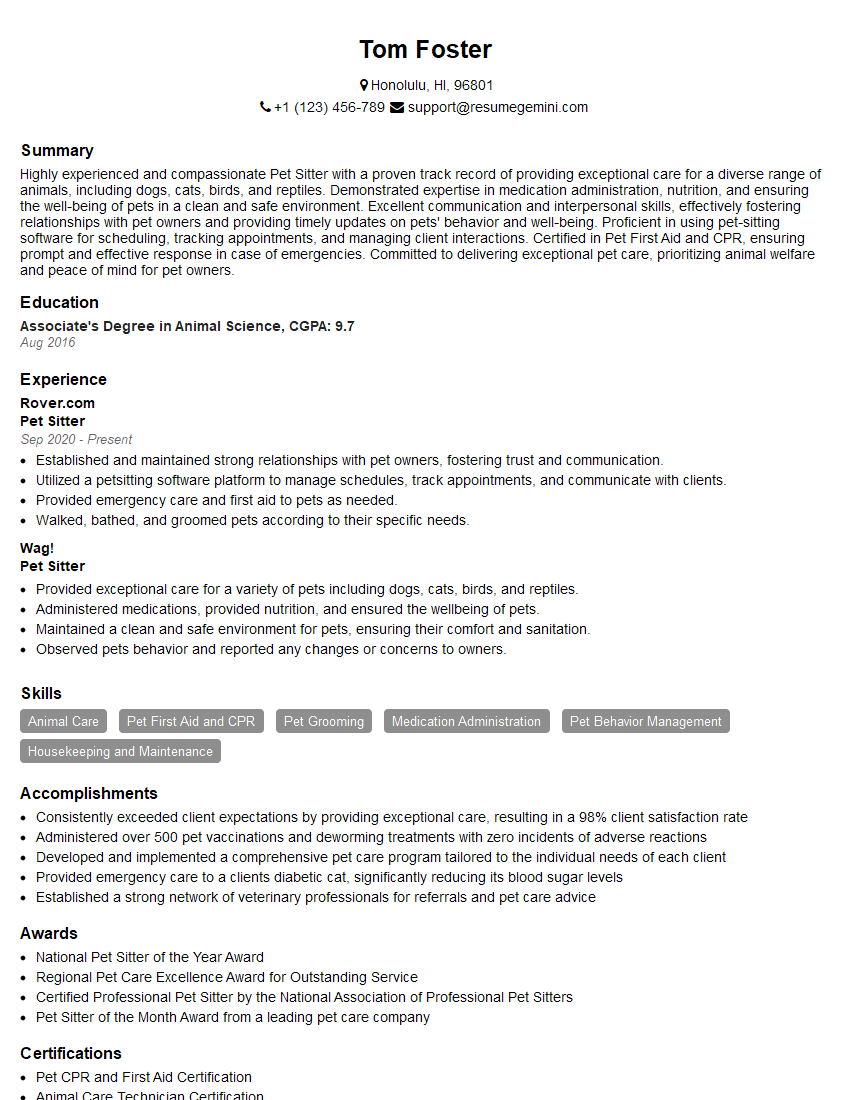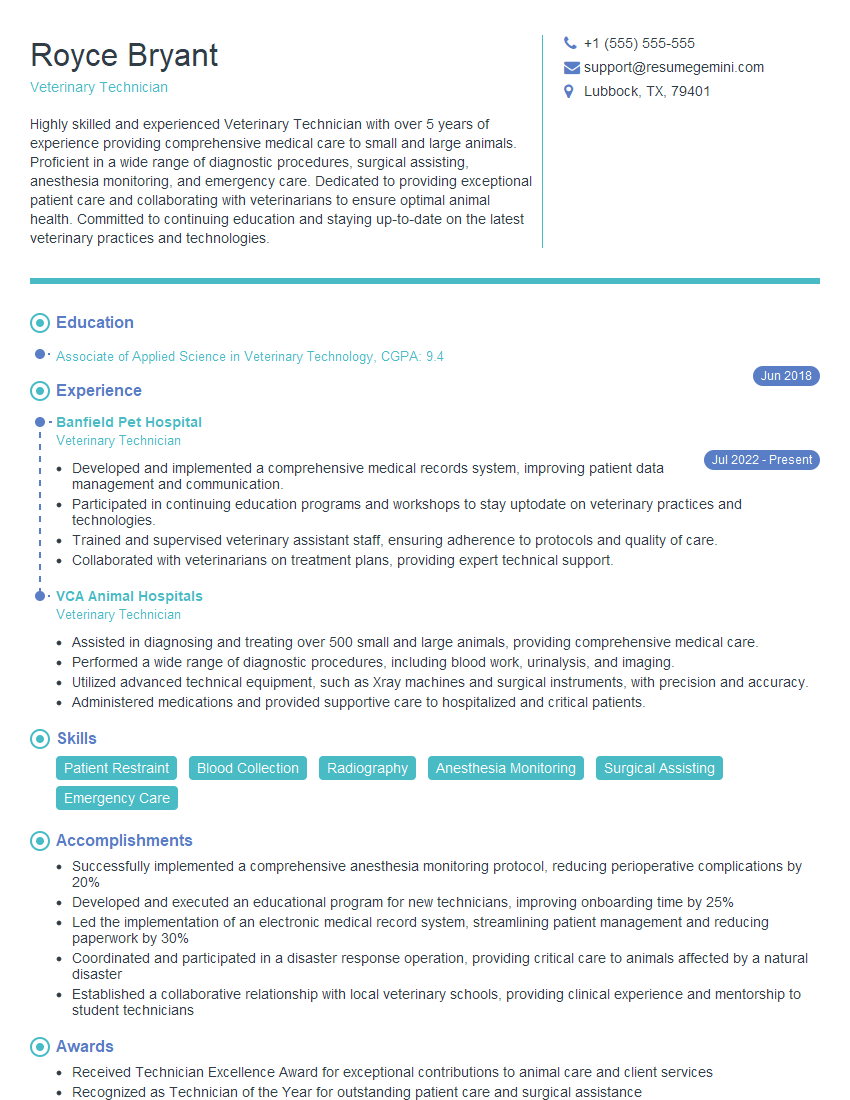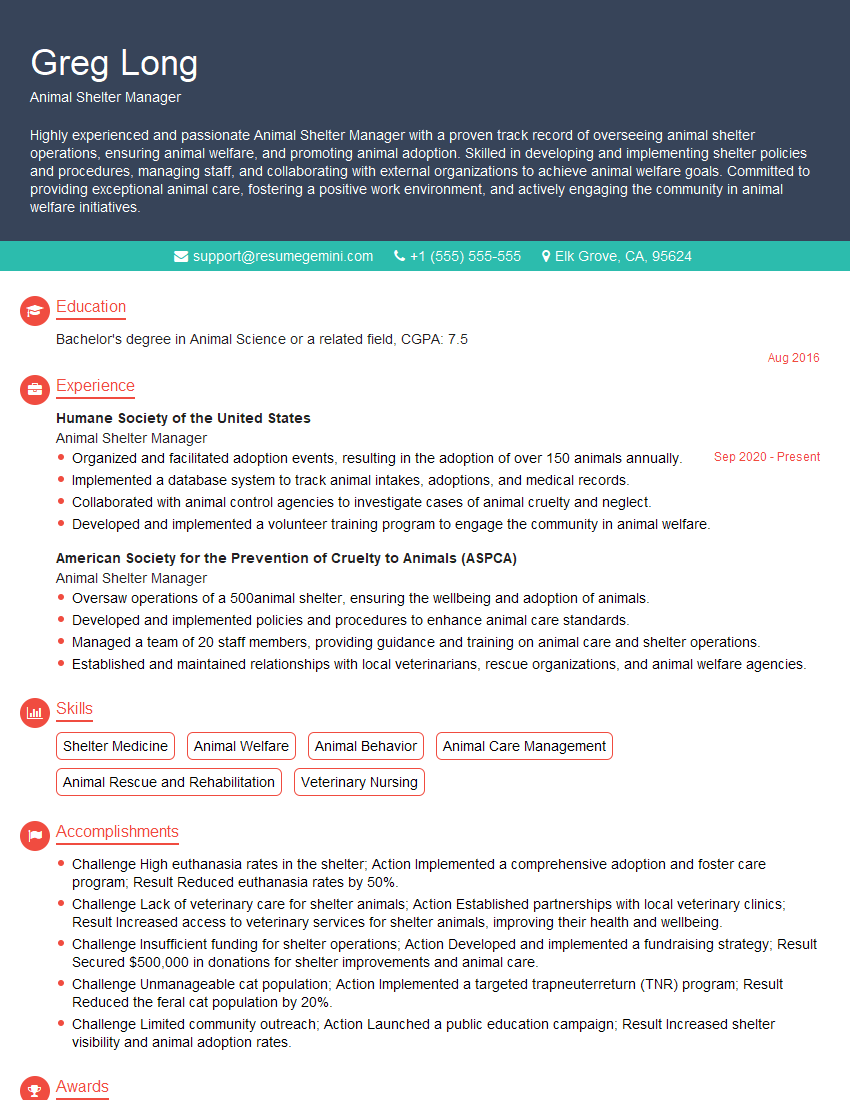Unlock your full potential by mastering the most common Comfortable working with animals in various conditions interview questions. This blog offers a deep dive into the critical topics, ensuring you’re not only prepared to answer but to excel. With these insights, you’ll approach your interview with clarity and confidence.
Questions Asked in Comfortable working with animals in various conditions Interview
Q 1. Describe your experience handling aggressive animals.
Handling aggressive animals requires a calm, confident approach and a deep understanding of animal behavior. My experience involves carefully assessing the situation before interacting. This means understanding the animal’s body language – signs like flattened ears, bared teeth, or a stiff posture indicate aggression.
I prioritize creating a safe distance and avoiding direct eye contact, which can be perceived as a challenge. Instead, I use slow, deliberate movements and a low, soothing voice. My approach always involves employing appropriate restraint techniques, selecting the safest and most effective method based on the species, size, and level of aggression. This might involve using specialized tools like catch poles, nets, or even just a strategically placed barrier.
For instance, I once had to handle a territorial rooster that aggressively attacked anyone who approached. Instead of confronting him directly, I used a long-handled net to gently guide him into a secure enclosure. The key is patience, understanding, and the right tools.
Q 2. How do you assess an animal’s health in various environments?
Assessing an animal’s health in various environments requires a systematic approach, adapting to the specific challenges each environment presents. Factors such as temperature, terrain, and access to resources all play a role. I begin by observing the animal’s overall demeanor – is it lethargic, alert, or showing signs of distress?
I then proceed with a physical examination, checking for things like abnormal posture, wounds, respiratory rate, heart rate, and body temperature. The tools I use depend on the setting. In a field setting, this might involve basic observation and palpation, while in a veterinary clinic, I’d have access to more advanced diagnostic equipment.
For example, assessing a wild bird requires a completely different approach than examining a domesticated cat. With a wild bird, I would prioritize minimizing stress and handling as little as possible, focusing on observing its behavior and looking for obvious signs of injury or illness from a distance. With a domesticated cat, a more hands-on examination is possible. The key is adapting the assessment to the individual animal and its circumstances.
Q 3. Explain your approach to managing animal stress during procedures.
Managing animal stress during procedures is crucial for both the animal’s well-being and the safety of the personnel involved. My approach is multifaceted and always starts with pre-emptive measures. This means creating a comfortable and secure environment for the animal before the procedure even begins. I use positive reinforcement techniques like gentle petting and soothing vocalizations. I also provide distractions like favorite toys or treats.
During the procedure itself, I use the minimum restraint necessary, choosing methods that minimize discomfort and pain. Pharmacological interventions, such as mild sedatives or analgesics, are used when appropriate and approved by a veterinarian. Post-procedure, I provide ample time for rest and recovery, along with continued positive reinforcement.
For instance, when administering vaccinations to a nervous dog, I would use a gentle, calm approach, offering treats and praise throughout. This helps to create a positive association with the experience, reducing future stress.
Q 4. What are the signs of animal illness or injury you’re trained to recognize?
Recognizing signs of illness or injury in animals is fundamental to providing effective care. Training has equipped me to identify a wide range of indicators, from the subtle to the obvious. These include changes in behavior (lethargy, aggression, isolation), appetite changes (loss of appetite, excessive thirst), respiratory issues (coughing, labored breathing), and visible injuries (wounds, limping).
Other warning signs include changes in urination or defecation, abnormal posture (hunched back, reluctance to move), skin changes (rashes, lesions), and ocular or nasal discharge. The specific signs vary greatly depending on the species and the underlying problem, requiring a holistic approach to diagnosis.
For example, a dog that suddenly becomes lethargic and refuses to eat might be suffering from a serious illness like parvovirus. A cat with matted fur and persistent scratching could indicate fleas or an allergic reaction. Recognizing these subtle cues helps in timely intervention.
Q 5. How do you ensure animal safety in diverse settings?
Ensuring animal safety in diverse settings demands a flexible and adaptable approach, prioritizing both the animal’s individual needs and the environment’s specific challenges. This starts with a thorough risk assessment before any interaction. This involves identifying potential hazards such as traffic, sharp objects, poisonous plants, and other animals.
My approach then involves using appropriate containment strategies. This could mean using secure cages, leashes, or even temporary barriers. I also make sure that the environment is appropriate for the animal’s needs, providing sufficient space, water, shelter, and enrichment. Constant supervision is crucial, particularly in unfamiliar surroundings or when working with multiple animals.
For example, working with animals in a zoo requires strict adherence to safety protocols and a deep understanding of the animal’s natural behaviors and potential for aggression. Working with animals in a farm setting requires a different set of precautions related to machinery and livestock interactions.
Q 6. Detail your experience with animal restraint techniques.
Animal restraint techniques are essential for safe and effective handling, and my experience encompasses a wide range of methods tailored to different species and situations. The core principle is always to use the least restrictive method possible while ensuring the safety of both the animal and the handler.
Techniques range from simple methods like gentle persuasion and distraction for docile animals to more specialized techniques involving physical restraint for aggressive or injured animals. These can include the use of specialized tools like muzzles, catch poles, or even chemical restraint (under veterinary supervision). Each technique requires proper training and a clear understanding of potential risks.
For example, safely restraining a large dog for a veterinary examination might involve using a combination of a gentle verbal approach, a secure leash, and maybe a muzzle, if necessary. Restraining a small rodent, on the other hand, would involve much gentler and less forceful techniques using specialized containers.
Q 7. Describe your method for administering medication to animals.
Administering medication to animals requires precision, safety, and a thorough understanding of the animal’s physiology and the medication itself. The method I use depends on the medication type (oral, injectable, topical), the animal’s species and temperament, and the dosage.
Oral medications are often administered using treats or pill pockets to disguise the taste. Injectable medications require sterile technique and appropriate needle sizes based on the animal’s size and the medication’s viscosity. Topical medications are applied directly to the skin or mucous membranes. In all cases, I prioritize safety and minimizing stress for the animal. Proper record-keeping of the administration is vital.
For example, giving a cat a liquid medication, I would use a small syringe to slowly administer the medicine to the side of its mouth, avoiding direct injection into its throat to prevent choking. For a dog requiring an injection, I would select the appropriate injection site and follow strict sterile protocols.
Q 8. How do you handle animal emergencies?
Handling animal emergencies requires swift, decisive action. My approach is based on a triage system, prioritizing immediate threats to life.
- Assessment: I begin by quickly assessing the animal’s condition, noting breathing, pulse, and any obvious injuries. This helps determine the severity and urgency.
- Stabilization: Next, I focus on stabilizing the animal. This might involve controlling bleeding, administering oxygen, or providing supportive care to prevent shock. For example, if a dog is hit by a car and is bleeding profusely, I would immediately apply pressure to the wound and prepare for transportation to a veterinary hospital.
- Treatment: Depending on my training and the situation, I may administer first aid, such as cleaning and bandaging wounds. However, my primary focus is always on getting the animal to veterinary care as quickly as possible for definitive treatment.
- Communication: Clear and concise communication with veterinary staff is crucial. I provide a detailed account of the situation, injuries, and any treatment already provided. This ensures seamless transition of care.
Regular training in animal first aid and CPR are essential components of my skillset, ensuring I am always prepared to effectively manage emergency situations.
Q 9. Explain your experience with different animal species.
My experience spans a wide range of species, from common domestic animals like dogs and cats to more exotic creatures such as birds of prey and reptiles.
- Canine and Feline Care: I have extensive experience in handling and caring for dogs and cats of various breeds and temperaments, including those with special needs. This includes administering medications, grooming, and providing enrichment activities.
- Equine Management: I’ve worked with horses, assisting in their grooming, feeding, and basic health checks. I understand their unique needs and behavioral nuances. I’ve even assisted with the handling of horses during veterinary procedures.
- Avian and Reptilian Care: My experience includes caring for birds, reptiles, and amphibians. This includes understanding their dietary requirements, creating appropriate habitats, and monitoring their health. For example, I learned the delicate process of feeding a baby hummingbird, requiring specialized techniques and equipment.
This diverse experience allows me to adapt my approach depending on the animal’s species and individual requirements. I am always willing to expand my knowledge through continued learning and training.
Q 10. Describe your knowledge of animal behavior and communication.
Understanding animal behavior and communication is fundamental to successful animal care. It’s not just about recognizing obvious signs; it’s about interpreting subtle cues.
- Body Language: I am proficient in interpreting various body language signals, such as ear position, tail wags, posture, and vocalizations. For instance, a dog with its tail tucked between its legs and ears pressed back is exhibiting signs of fear or submission, requiring a different approach than a dog with a playful, wagging tail.
- Species-Specific Communication: My knowledge extends to understanding the specific communication methods of various species. For example, birds use songs and displays for communication, while reptiles rely on pheromones and visual cues.
- Environmental Factors: I consider the impact of environmental factors on animal behavior. For example, a stressed animal may exhibit different behavior than a relaxed one.
Effective communication is key to building trust and ensuring the animal’s well-being. This skill is crucial for preventing and resolving conflict and ensuring safe and efficient handling.
Q 11. How do you maintain a clean and sanitary environment for animals?
Maintaining a clean and sanitary environment is paramount for preventing disease and promoting animal welfare. My approach follows strict protocols.
- Regular Cleaning: Daily cleaning and disinfection of enclosures and surfaces are essential. This includes removing feces, urine, and any spilled food.
- Waste Disposal: Proper waste disposal is crucial to prevent the spread of pathogens. I adhere to strict protocols for handling and disposing of animal waste.
- Disinfection: I use appropriate disinfectants to eliminate bacteria and viruses. The choice of disinfectant depends on the species and the type of surface being cleaned. I always follow the manufacturer’s instructions to ensure effectiveness and avoid harming the animals.
- Ventilation: Ensuring proper ventilation is critical to maintain air quality and prevent the buildup of harmful gases such as ammonia.
A clean environment not only improves the animals’ health but also contributes to a more pleasant and safe working environment for the handlers.
Q 12. What is your experience with animal nutrition?
Animal nutrition is a critical aspect of animal care, impacting health, growth, and overall well-being. My knowledge encompasses the specific dietary requirements of various species.
- Species-Specific Diets: I understand that different species have vastly different nutritional needs. For example, carnivores require a diet rich in protein, while herbivores require a diet high in fiber. I am familiar with formulating balanced diets for different animals based on their age, activity level, and health status.
- Nutritional Deficiencies: I can recognize signs of nutritional deficiencies and take appropriate steps to correct them. This might involve adjusting the diet or providing nutritional supplements under veterinary supervision.
- Feeding Practices: I am skilled in implementing appropriate feeding practices, such as providing fresh food and water regularly, monitoring food intake, and preventing food waste.
Proper nutrition plays a significant role in disease prevention and promoting healthy growth and development in animals. Understanding nutritional requirements for different species and life stages is essential to my work.
Q 13. How do you prevent the spread of disease among animals?
Preventing disease spread is critical in animal care. My strategies combine preventative measures with prompt action if disease occurs.
- Quarantine: New animals are always quarantined to monitor for signs of illness before introducing them to the general population.
- Vaccination: Implementing vaccination programs is a cornerstone of preventative medicine. I ensure animals receive appropriate vaccines at the recommended intervals.
- Hygiene Protocols: Strict hygiene protocols are followed, including hand washing, disinfection, and the use of personal protective equipment (PPE) to minimize the risk of cross-contamination.
- Parasite Control: Regular parasite control measures, such as deworming, flea and tick treatments, are implemented as needed.
- Prompt Veterinary Attention: Any signs of illness are reported immediately to a veterinarian for diagnosis and treatment. Early intervention is key to controlling outbreaks.
A proactive approach to disease prevention is essential, minimizing animal suffering and protecting the entire population from disease outbreaks.
Q 14. What is your approach to animal socialization?
Animal socialization is vital for their mental and physical well-being. My approach is tailored to the individual animal and their species.
- Gradual Introduction: For animals unfamiliar with other animals, I use a gradual introduction process. This might involve supervised interactions in a neutral territory, allowing animals to get used to each other’s presence gradually.
- Positive Reinforcement: I use positive reinforcement techniques such as rewards and praise to encourage appropriate social interactions. This helps build confidence and positive associations with other animals.
- Species-Specific Considerations: Socialization techniques vary widely depending on the species. For example, socializing a dog differs significantly from socializing a parrot or a reptile.
- Environmental Enrichment: Providing an enriched environment with opportunities for play and exploration can reduce stress and promote positive social interactions.
Successful socialization leads to well-adjusted animals that are confident and capable of interacting appropriately with other animals and humans.
Q 15. Describe your experience with animal training methods.
My approach to animal training is rooted in positive reinforcement, focusing on rewarding desired behaviors rather than punishing unwanted ones. This method builds trust and a positive association with training, leading to better results in the long run. I utilize a variety of techniques adapted to the specific animal and its learning style.
- Clicker Training: I frequently use clicker training, pairing a click sound with a reward (treat, praise, toy) to mark the exact moment a desired behavior occurs. This provides clear, immediate feedback for the animal. For example, I might use this to train a dog to sit, rewarding the moment its rear touches the ground.
- Shaping: This involves breaking down complex behaviors into smaller, manageable steps, rewarding each successive approximation towards the final goal. Imagine teaching a horse to bow; I’d start by rewarding head lowering, then progressively lower head positions, until eventually rewarding the full bow.
- Luring and Targeting: Using a lure (treat or toy) to guide an animal into a desired position or action, gradually fading the lure’s dependence as the animal learns the behavior. This is effective for teaching things like fetching or walking in a heel position.
I believe in consistent and patient training, understanding that every animal learns at its own pace. My training always prioritizes the animal’s well-being and avoids any methods that could cause stress or harm.
Career Expert Tips:
- Ace those interviews! Prepare effectively by reviewing the Top 50 Most Common Interview Questions on ResumeGemini.
- Navigate your job search with confidence! Explore a wide range of Career Tips on ResumeGemini. Learn about common challenges and recommendations to overcome them.
- Craft the perfect resume! Master the Art of Resume Writing with ResumeGemini’s guide. Showcase your unique qualifications and achievements effectively.
- Don’t miss out on holiday savings! Build your dream resume with ResumeGemini’s ATS optimized templates.
Q 16. How do you handle animal waste disposal?
Safe and responsible animal waste disposal is paramount to maintaining hygiene and preventing disease transmission. My approach depends on the animal and the environment.
- Dogs and Cats: I always use biodegradable, readily available waste bags, ensuring immediate disposal in designated receptacles. In areas lacking such facilities, I would temporarily store waste in sealed bags until proper disposal is possible.
- Larger Animals (Horses, Livestock): Waste management varies considerably. For horses, manure is often collected and composted, a sustainable method reducing landfill waste and producing valuable fertilizer. For livestock, managing manure often involves composting or spreading it on fields as fertilizer, following local regulations regarding environmental protection.
- Wildlife: Handling waste from wildlife requires caution and adherence to any specific guidelines. Generally, I try to minimize my impact and ensure the surrounding area remains undisturbed. If possible, I may report the matter to the relevant authorities.
Thorough handwashing with soap and water is crucial after any waste handling procedure, to prevent cross-contamination.
Q 17. How do you adapt your techniques to different animal temperaments?
Adapting my techniques to different animal temperaments is essential for effective and safe interaction. I use observation and careful assessment to determine an animal’s personality and needs.
- Shy or Fearful Animals: I use a slow, gradual approach, allowing the animal to acclimate to my presence at its own pace. I avoid sudden movements or loud noises, prioritizing building trust through positive reinforcement and gentle handling.
- Dominant or Aggressive Animals: Safety is paramount. I use caution, clear boundaries, and assertive yet calm body language. I may employ techniques like using a long lead to maintain distance while still interacting. Positive reinforcement is still key, focusing on rewarding calm behavior.
- Energetic or Playful Animals: I channel their energy into positive activities, such as structured play sessions or training exercises. I ensure that sessions are not overstimulating and that the animal has sufficient opportunities for rest.
Understanding each animal’s unique needs and responding accordingly is crucial for building a positive relationship and achieving training goals.
Q 18. Describe a time you had to make a quick decision regarding animal welfare.
During a wildlife rescue operation, we encountered a severely injured hawk. Initial assessment showed a broken wing and signs of dehydration. We were in a remote location with limited resources. I had to make a quick decision: attempt immediate stabilization and transport for veterinary care, or risk further injury by delaying the process. Considering the hawk’s condition, I opted for immediate action.
We carefully stabilized the wing using improvised splints and provided water via a dropper. We then transported it to the nearest veterinary clinic, prioritizing speed and safety. The rapid response was crucial, significantly improving the hawk’s chances of survival. The hawk ultimately recovered and was later released back into the wild. This experience reinforced the importance of rapid assessment, informed decision-making, and the crucial role of teamwork in animal welfare emergencies.
Q 19. What is your understanding of animal welfare regulations?
My understanding of animal welfare regulations is comprehensive. I am well-versed in local, national, and, when applicable, international standards. These regulations encompass several key areas:
- Housing and Environmental Enrichment: Animals must have appropriate housing to meet their physical and behavioral needs, with adequate space, temperature control, and opportunities for exercise and social interaction.
- Nutrition and Hydration: Animals require access to sufficient high-quality food and clean, fresh water.
- Veterinary Care: Provision of preventative and necessary veterinary care, including vaccinations, parasite control, and prompt treatment of illnesses and injuries.
- Handling and Transportation: Safe and humane handling and transportation methods that minimize stress and injury.
- Specific Species Regulations: There are specific regulations governing particular species, such as endangered animals or animals used for research.
Staying updated on any changes or developments in animal welfare legislation is ongoing professional development for me. Adherence to these regulations is not just a legal obligation, but an ethical imperative.
Q 20. How do you handle difficult or uncooperative animal owners?
Handling difficult or uncooperative animal owners requires tact, empathy, and clear communication. My approach involves:
- Active Listening: I begin by attentively listening to their concerns and perspectives. Often, their uncooperative behavior stems from misunderstanding or frustration.
- Educating and Explaining: I clearly explain the animal’s needs and the rationale behind recommended care practices, using simple, non-judgmental language.
- Offering Practical Solutions: I offer feasible solutions tailored to their circumstances, providing options and support rather than dictating demands.
- Setting Boundaries: While maintaining a respectful dialogue, I firmly set boundaries regarding animal welfare. If necessary, I may involve other professionals, such as animal welfare agencies, to ensure the animal’s safety and well-being.
- Documentation: I thoroughly document all interactions, noting concerns and resolutions taken. This is critical for transparency and potential future reference.
My priority is always the animal’s welfare. While I strive to maintain a positive relationship with owners, I won’t compromise the animal’s needs.
Q 21. Explain your experience working in varied weather conditions.
My experience working in varied weather conditions is extensive, encompassing everything from scorching summers to freezing winters. Adapting to such conditions is crucial for both my safety and the animals under my care.
- Heat: In hot weather, I prioritize providing shade, access to cool water, and limiting strenuous activity during the hottest parts of the day. I also ensure proper ventilation and monitor for signs of heat stress.
- Cold: During cold weather, I ensure animals have appropriate shelter, protection from wind and precipitation, and access to adequate bedding. Monitoring for hypothermia and adjusting their routine as needed is essential.
- Rain/Snow: I take precautions to ensure both myself and the animals stay dry. This might involve using protective gear, providing sheltered areas, or adjusting activity schedules.
I always prioritize the animals’ safety and comfort by adapting my work practices to the prevailing weather conditions. Regular assessments of the animals and the environment are critical for their well-being. I always wear appropriate clothing and safety gear to protect myself as well.
Q 22. How do you maintain accurate animal records?
Maintaining accurate animal records is crucial for responsible animal care and is the cornerstone of any successful animal operation. It ensures the well-being of the animals, aids in disease prevention and treatment, and is vital for regulatory compliance. My approach involves a multi-faceted system combining digital and physical records.
Digital Database: I utilize specialized software, often customized for the specific species and needs of the animals in my care. This allows for easy data entry, searching, and reporting. Fields typically include animal ID (microchip, ear tag), species, breed, date of birth, vaccination history, medical treatments, dietary requirements, behavioral observations, and any other relevant information. Think of it like a comprehensive health record for each animal.
Physical Records: I also maintain physical copies of important documents such as veterinary certificates, import/export permits, and breeding records. These serve as backups in case of digital system failure. All records are clearly labeled, organized, and stored in a secure, easily accessible location.
Regular Updates: Consistent updates are paramount. I make it a routine to update records daily, noting any changes in an animal’s health, behavior, or environment. This prevents errors and ensures data accuracy.
Data Backup and Security: Regular data backups are essential, using both cloud storage and local backups. Security measures are in place to protect sensitive information, such as access controls and password protection.
For example, during my work at a wildlife rehabilitation center, I meticulously documented each animal’s intake, treatment progress, and eventual release, using a combination of a digital database and physical notebooks. This system allowed us to track the success of our rehabilitation programs and improve our practices.
Q 23. Describe your experience with specialized animal equipment.
My experience with specialized animal equipment is extensive and encompasses a wide range of tools and technologies. I’m proficient in operating and maintaining equipment for various animal species and settings. This expertise covers everything from basic tools to sophisticated technologies.
Basic Handling Equipment: I am comfortable and skilled in using nets, leashes, carriers, and other tools for safe animal restraint and handling, adjusting techniques depending on the species and individual animal’s temperament.
Medical Equipment: I have experience with various medical instruments and devices, such as scales, thermometers, stethoscopes, syringes, and intravenous catheters, maintaining them meticulously and using them appropriately under veterinary supervision when necessary. I’m also familiar with operating and maintaining specialized medical equipment like X-ray machines or ultrasound machines in a veterinary setting.
Environmental Control Equipment: I’m proficient with equipment used to control animal environments, including climate control systems (heating, cooling, ventilation), filtration systems (for aquariums or specialized enclosures), and lighting systems. Regular maintenance and calibration of such systems are crucial and are integral to my work.
Specialized Equipment: My experience includes working with specialized equipment tailored to specific animal species or tasks, such as incubators for reptile eggs, specialized feeding apparatus for picky eaters, or enrichment devices for cognitive stimulation.
For example, during my time at a zoo, I learned to operate and maintain the specialized equipment used in their primate enclosure, including automated feeding systems and enrichment devices that ensured the well-being of the animals in their care.
Q 24. How do you stay updated on best practices in animal care?
Staying updated on best practices in animal care is an ongoing process and a crucial aspect of responsible animal handling. The field is constantly evolving with new research and technological advancements.
Professional Development: I regularly attend conferences, workshops, and seminars focused on animal care, welfare, and species-specific best practices. This allows me to network with other professionals and learn from experts in the field.
Continuing Education Courses: I actively pursue continuing education courses and certifications relevant to my specialization. These courses keep me abreast of the latest techniques and regulations.
Professional Journals and Publications: I subscribe to and regularly read professional journals and publications that focus on animal care, veterinary medicine, and related fields. This allows me to stay informed about new research findings and emerging trends.
Online Resources and Networks: I utilize online resources, such as reputable websites and professional networks, to access the latest information and engage with experts in the field. Online forums and discussions are valuable for insights into new techniques and challenges faced by other professionals.
Mentorship and Collaboration: I actively seek mentorship from experienced professionals and collaborate with colleagues to share knowledge and learn from their experiences. This collaborative approach facilitates continuous improvement and learning.
For instance, recently I attended a workshop on the latest techniques in avian rehabilitation, which significantly improved my ability to care for injured birds.
Q 25. What is your experience with animal transport and handling?
Safe and efficient animal transport and handling are paramount, requiring a thorough understanding of species-specific needs and risk mitigation strategies. My experience covers a broad range of scenarios and species.
Species-Specific Handling: I understand the unique handling requirements of various species, adapting my techniques based on size, temperament, and potential risks. This includes using appropriate restraint methods to minimize stress and ensure safety for both the animal and handler.
Transport Methods: I am experienced in using different modes of transport, from standard animal carriers and crates to specialized vehicles designed for larger or more sensitive animals. I ensure proper ventilation, temperature control, and secure confinement during transport.
Safety Protocols: I strictly adhere to safety protocols during transport and handling, including the use of appropriate personal protective equipment (PPE), such as gloves, masks, and protective clothing, when needed. Risk assessments are crucial before any transport operation.
Emergency Preparedness: I’m prepared for potential emergencies during transport, having knowledge of first-aid procedures for animals and knowing how to handle unforeseen situations such as escapes or medical emergencies.
For example, I once assisted in the transport of a rescued sea turtle to a rehabilitation facility, ensuring its safe and comfortable journey using a specialized crate with proper support and climate control.
Q 26. How would you approach a situation involving a potentially dangerous animal?
Encountering a potentially dangerous animal requires a calm, decisive, and informed approach. Prioritizing safety is paramount for both the animal and the handler. My response would follow a structured protocol.
Assessment and Distance: My first step would be to assess the situation from a safe distance, observing the animal’s behavior and body language to gauge its level of aggression or threat. Maintaining a safe distance is crucial.
Environmental Considerations: I would take into account the environment and available escape routes for both myself and the animal. Understanding the animal’s surroundings can help predict its potential actions.
Appropriate Response: The response depends on the specific animal and situation. This could range from slowly backing away and avoiding eye contact to seeking help from qualified professionals, such as animal control or wildlife specialists, if the situation is too risky to manage independently.
Specialized Equipment: If intervention is necessary, I would utilize appropriate safety equipment, including protective gear, tranquilizer equipment (if certified and permitted), and specialized handling tools to minimize risk. I would only attempt intervention if I’m appropriately trained and equipped.
Post-Incident Protocol: After any interaction, a thorough report needs to be documented, including details of the incident, actions taken, and any injuries sustained. This information is crucial for improving safety procedures and preventing future incidents.
For example, during my time working at a wildlife sanctuary, we had a situation with an aggressive boar. We contacted animal control, who safely captured and relocated the animal, minimizing any risks to humans or the animal itself.
Q 27. Describe your experience with different types of animal housing.
My experience with different types of animal housing is diverse, encompassing various designs and considerations based on species-specific needs and environmental factors. A suitable habitat is vital for animal welfare.
Indoor Enclosures: I have experience designing, setting up, and maintaining indoor enclosures for various animals, ensuring adequate space, proper ventilation, temperature control, and enrichment features. These can range from simple cages to complex indoor aviaries or terrariums.
Outdoor Enclosures: I’m proficient in creating and managing outdoor enclosures for animals, considering factors such as shelter from the elements, appropriate substrate, access to water, and security. These can range from simple runs for small animals to large paddocks or open-range enclosures for larger animals.
Specialized Housing: I’ve worked with specialized housing for specific species, such as aquariums for aquatic animals, specialized enclosures for reptiles and amphibians that regulate humidity and temperature, or enclosures designed to replicate natural habitats.
Hygiene and Maintenance: Regardless of the type of housing, regular cleaning and maintenance are crucial. I am experienced in maintaining hygiene standards to prevent disease transmission and ensure animal welfare. Regular inspections for structural integrity are also paramount.
For instance, at a veterinary clinic, I assisted in setting up and maintaining a specialized enclosure for a recovering injured bird of prey, ensuring it was a safe and stimulating environment conducive to its recovery.
Q 28. How would you identify and address signs of animal neglect or abuse?
Identifying and addressing signs of animal neglect or abuse is a serious responsibility that requires a keen eye for detail and a knowledge of animal behavior. My approach involves a systematic process.
Observation: I regularly observe the animals under my care, noting any changes in their behavior, appearance, or physical condition. This includes looking for signs such as malnutrition, dehydration, injuries, unusual lethargy, or behavioral changes.
Comparison: I compare the current state of the animal to its previous condition or expected condition for its age and species. Any significant deviations warrant further investigation.
Record Keeping: Maintaining detailed records of observations and any unusual occurrences is vital. These records provide a timeline of events and support any necessary interventions.
Reporting and Intervention: If I suspect neglect or abuse, I immediately report my findings to the appropriate authorities, such as animal control, the humane society, or veterinary services. The well-being of the animal is my top priority.
Documentation: I meticulously document all evidence, including photographs or videos of any injuries or neglectful conditions. This documentation serves as critical evidence in any investigation.
In a previous role, I noticed that a dog in a client’s care was significantly underweight and lethargic. After several attempts to discuss proper care with the owner yielded no results, I reported the situation to the relevant authorities, leading to intervention and improved care for the animal.
Key Topics to Learn for Comfortable Working with Animals in Various Conditions Interview
- Animal Handling Techniques: Understanding safe and effective handling procedures for diverse animal species, including proper restraint and minimizing stress.
- Species-Specific Needs: Demonstrating knowledge of the unique behavioral, physical, and dietary requirements of different animals (e.g., dogs, cats, birds, livestock).
- Recognizing Animal Distress: Identifying signs of illness, injury, or discomfort in animals, and knowing appropriate response protocols.
- Environmental Adaptation: Discussing experience working with animals in various settings, such as shelters, veterinary clinics, farms, or zoos, and adapting techniques accordingly.
- Hygiene and Sanitation: Understanding and implementing appropriate hygiene and sanitation procedures to maintain a safe and healthy environment for animals and staff.
- Emergency Procedures: Describing experience with handling animal emergencies, first aid, and knowing when to seek veterinary assistance.
- Communication and Teamwork: Highlighting skills in communicating effectively with colleagues, supervisors, and clients regarding animal care and concerns.
- Ethical Considerations: Demonstrating an understanding of animal welfare principles and ethical handling practices.
- Problem-Solving and Adaptability: Illustrating your ability to think critically and adapt your approach to different situations and animal behaviors.
Next Steps
Mastering the skills related to comfortable working with animals in various conditions is crucial for career advancement in many animal-related fields. A strong resume showcasing these abilities is essential for securing your dream job. To maximize your chances, focus on creating an ATS-friendly resume that highlights your relevant skills and experience effectively. ResumeGemini is a trusted resource to help you build a professional and impactful resume. We provide examples of resumes tailored to roles requiring comfortable working with animals in various conditions to guide you in crafting your own compelling application.
Explore more articles
Users Rating of Our Blogs
Share Your Experience
We value your feedback! Please rate our content and share your thoughts (optional).
What Readers Say About Our Blog
Hello,
We found issues with your domain’s email setup that may be sending your messages to spam or blocking them completely. InboxShield Mini shows you how to fix it in minutes — no tech skills required.
Scan your domain now for details: https://inboxshield-mini.com/
— Adam @ InboxShield Mini
Reply STOP to unsubscribe
Hi, are you owner of interviewgemini.com? What if I told you I could help you find extra time in your schedule, reconnect with leads you didn’t even realize you missed, and bring in more “I want to work with you” conversations, without increasing your ad spend or hiring a full-time employee?
All with a flexible, budget-friendly service that could easily pay for itself. Sounds good?
Would it be nice to jump on a quick 10-minute call so I can show you exactly how we make this work?
Best,
Hapei
Marketing Director
Hey, I know you’re the owner of interviewgemini.com. I’ll be quick.
Fundraising for your business is tough and time-consuming. We make it easier by guaranteeing two private investor meetings each month, for six months. No demos, no pitch events – just direct introductions to active investors matched to your startup.
If youR17;re raising, this could help you build real momentum. Want me to send more info?
Hi, I represent an SEO company that specialises in getting you AI citations and higher rankings on Google. I’d like to offer you a 100% free SEO audit for your website. Would you be interested?
Hi, I represent an SEO company that specialises in getting you AI citations and higher rankings on Google. I’d like to offer you a 100% free SEO audit for your website. Would you be interested?
good
